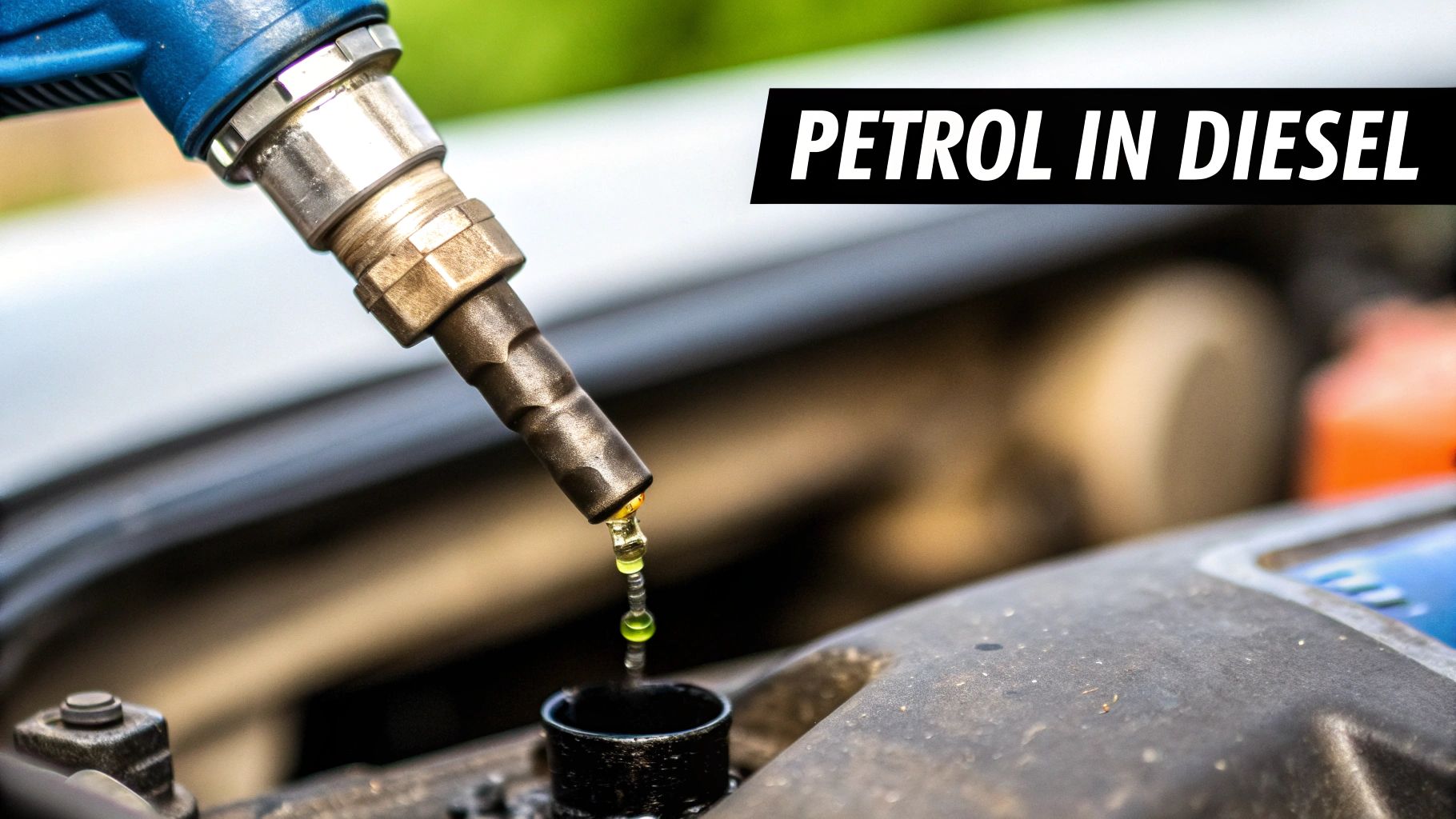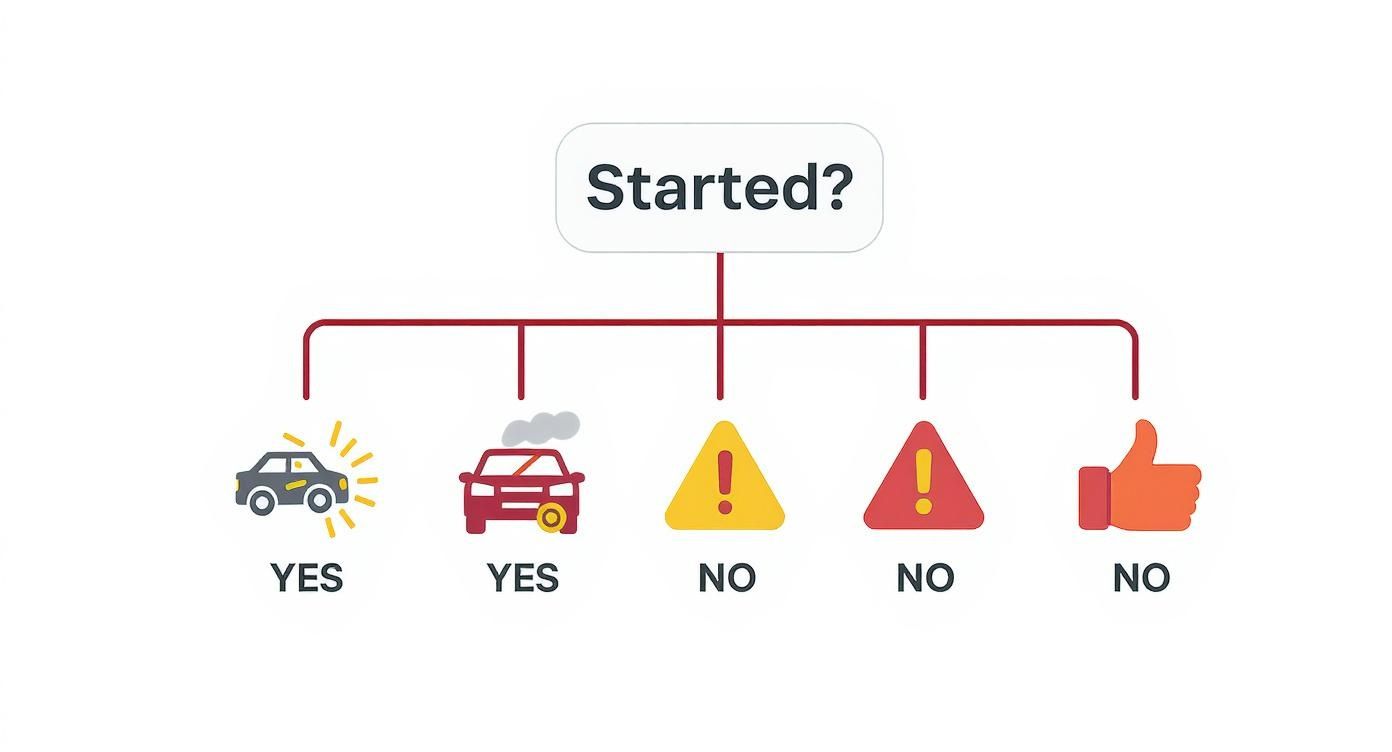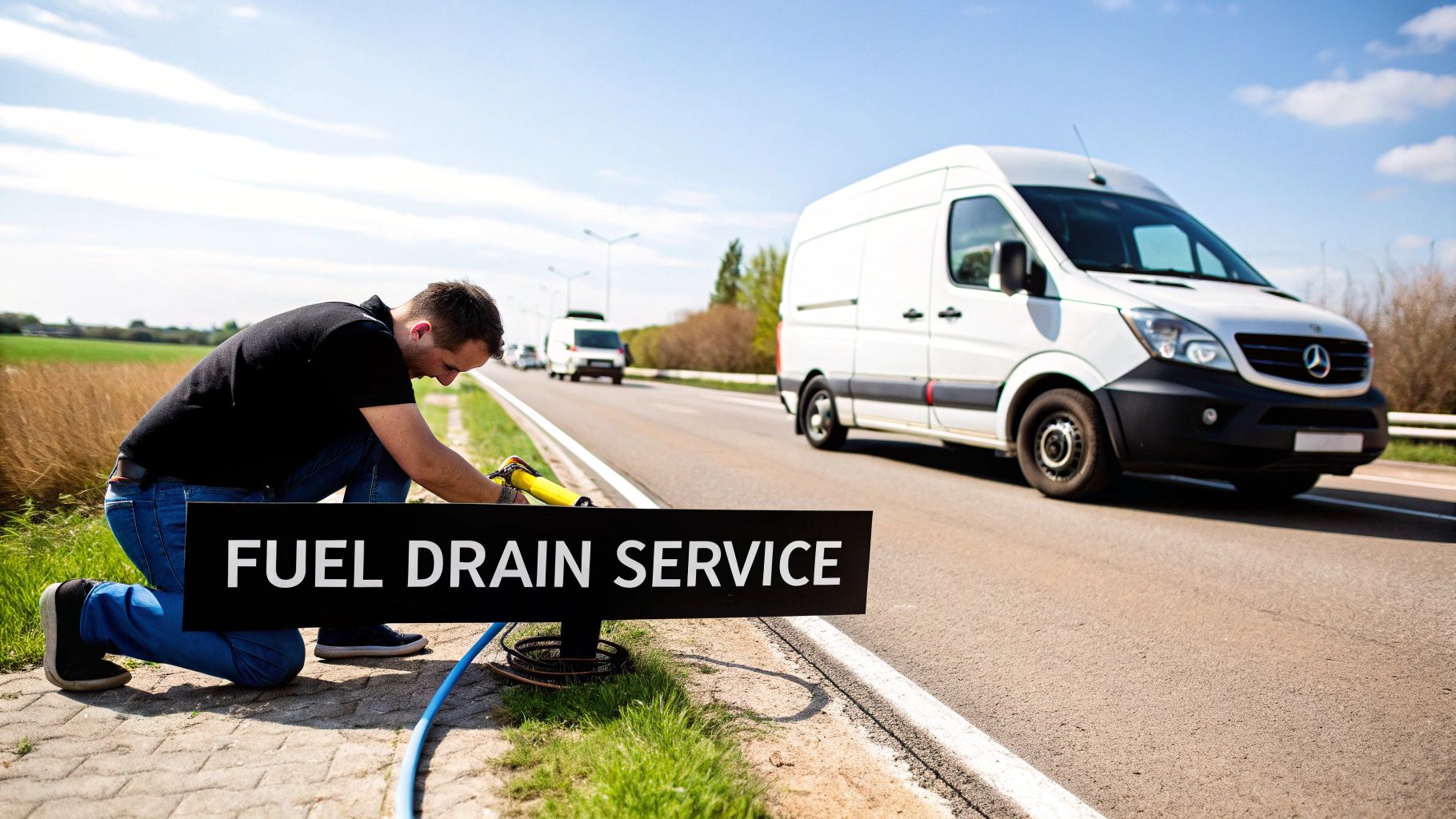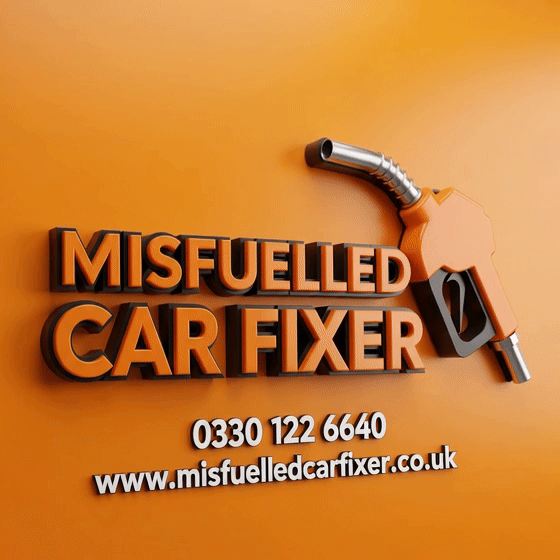Petrol in Diesel Car Symptoms: What to Do Now
- Misfuelled Car Fixer

- 2 days ago
- 13 min read
It’s a surprisingly easy mistake to make, but putting petrol in a diesel car can cause some seriously unpleasant symptoms. You might notice everything from a rattling engine and a sudden loss of power to clouds of smoke billowing from your exhaust. The root of the problem is that petrol acts like a solvent, stripping away the lubrication your diesel engine desperately needs and causing damaging friction between its metal parts.
What Happens When Petrol Meets a Diesel Engine

To really get your head around the symptoms, you need to know just how different petrol and diesel are. Think of diesel as an oily, protective lubricant. It’s not just there for the bang; it’s designed to keep the incredibly precise components of your high-pressure fuel pump and injectors moving friction-free. These parts are built to microscopic tolerances and absolutely depend on diesel's oiliness to prevent grinding themselves to bits.
Petrol is the complete opposite. It's much more like a powerful degreaser or a solvent. The moment it gets into a diesel system, it starts washing away that vital lubricating film.
The Immediate Mechanical Impact
Without that protective layer, the moving metal parts inside the fuel pump and injectors start grinding against one another. This friction creates a huge amount of heat and sends tiny metal fragments—we call this swarf—circulating through your fuel system. How bad the damage gets boils down to one simple question: did you start the engine?
Engine Off: If you caught the mistake at the pump and left the keys out of the ignition, the petrol is still just sitting in the fuel tank. It’s not ideal, but it’s containable. The destructive solvent hasn't been pumped through the most delicate—and most expensive—parts of your engine. A professional drain should sort it.
Engine On: The second you turn that key, the fuel pump whirs into life. It starts sucking the petrol-diesel mix from the tank and pushing it through the entire system. This is where the real damage starts, as that metal-on-metal grinding begins to destroy the fuel pump and injectors from the inside.
The core issue isn't just about the wrong type of bang in the engine; it's a total lubrication failure. Petrol strips the protective oily film from high-precision components, causing them to self-destruct. You can learn more about why by understanding the difference between petrol and diesel fuel.
It’s this rapid mechanical breakdown that causes all the classic symptoms you'll notice if you try to drive away.
What are the Telltale Signs of Misfuelling?
If you've turned the key after putting petrol in your diesel, the engine won't suffer in silence. It's going to send out some very obvious distress signals, and recognising them quickly can be the difference between a simple fuel drain and a bill for thousands in engine repairs.
The symptoms all point back to one core problem: petrol has none of the lubricating qualities diesel relies on, and it ignites completely differently under pressure. Let's break down what you're likely to see, hear, and feel.
What You'll See, Hear, and Feel
One of the first things you'll probably notice is a change in the engine's sound. Diesel engines have that familiar, deep clatter. But with petrol in the mix, this noise often changes to a much sharper, metallic sound.
You might hear a loud knocking or ‘pinking’ noise, especially when you put your foot down to accelerate. This is the sound of the engine literally fighting against itself. Petrol is far more volatile than diesel and can detonate uncontrollably under the high-compression conditions inside a diesel engine, instead of burning in a controlled way. It’s a very unhealthy sound.
At the same time, the car's performance will fall off a cliff. This usually shows up in a few ways:
Sudden Loss of Power: The car will feel sluggish and weak. You'll press the accelerator, but nothing much will happen. Trying to get up a hill or even maintain speed will become a real struggle.
Rough, Shaky Idling: When you're stopped at a junction or in traffic, the engine will likely judder and vibrate erratically. That steady, rhythmic pulse of a healthy diesel will be gone.
Frequent Stalling: The engine may cut out again and again, especially when you're moving slowly or idling. It'll feel like you're constantly fighting to keep it running.
Performance problems are almost always the first sign drivers notice. It’s a surprisingly common mistake, affecting thousands of drivers across the UK every year. In fact, a 2020 survey of nearly 3,500 emergency misfuelling callouts found that petrol-in-diesel incidents made up around 70% of the total. You can discover more diesel facts and figures on the Friends of the Earth UK website.
Quick Guide to Petrol in Diesel Symptoms
To make it even clearer, here’s a quick reference guide to the common signs that you’ve started a diesel car with petrol in the tank.
Remember, any one of these signs is a serious warning. If you notice a combination of them, it's almost certain you have a fuel problem.
Visual Red Flags You Can't Ignore
The visual clues are usually the final confirmation that you've got a fuel contamination issue. They tend to appear just after the performance starts to dip, and they are your car's way of screaming for you to stop right now.
The most dramatic sign is excessive smoke coming from the exhaust. We're not talking about the small puff of black smoke you might see from an older diesel. This will be thick clouds of white or greyish smoke. This is happening because the unburnt petrol and diesel mix is getting blasted into the hot exhaust, where it's essentially being boiled into a vapour.
Key Takeaway: White or grey exhaust smoke is a major red flag. It’s a clear sign that fuel is not burning correctly and is instead passing through the engine as a hot, damaging vapour. Find a safe place to pull over immediately.
Last but not least, your dashboard will almost certainly light up like a Christmas tree. Keep an eye out for the engine management light (EML) or the glow plug warning light either staying on or flashing. These lights are the car's brain telling you it has detected a serious problem with the engine or fuel system. Ignoring them is a surefire way to turn a bad situation into a catastrophic one.
Your Immediate Action Plan After Misfuelling
It’s that sinking feeling every driver dreads. You're at the pump, you hang up the nozzle, and then you see it – the green handle, not the black one. If you’ve just put petrol in your diesel car, the first thing to do is take a deep breath and stay calm. What you do in the next few minutes is absolutely critical and can mean the difference between a simple, inexpensive fix and a repair bill that runs into the thousands.
The single most important rule is non-negotiable: DO NOT start the engine. Seriously. Don't even turn the key to get the radio on. Just turning the ignition to the 'on' or 'accessory' position can be enough to prime the fuel pump, which will instantly start sending the damaging petrol into your car’s very sensitive fuel system.
If You Haven't Started the Car
If you realised your mistake before turning the key, you've just saved yourself a massive headache. The contaminated fuel is sitting harmlessly in the tank, well away from the engine's most delicate and expensive parts.
Here’s exactly what to do:
Keys Out: Take the keys right out of the ignition. Don't be tempted to put them back in.
Tell the Staff: Let the petrol station attendant know what's happened. They've seen it all before and can help cordon off the pump and keep the area safe.
Gear to Neutral: Pop the car into neutral.
Push it Safe: With some help, push the car to a safe parking spot, well away from the busy pumps.
This quick infographic neatly sums up the crucial split-second decision and its consequences.

As you can see, keeping that engine off is the key. It completely prevents the nasty petrol in diesel car symptoms from ever starting and contains the problem right where it is.
If You Have Already Driven Away
Maybe you drove off without realising, and now the car is starting to act up. You're hearing a knocking sound, the engine is losing power, or you see smoke puffing from the exhaust. You need to act, and you need to act now.
Your engine's survival depends on shutting it down as fast as safely possible. The longer it runs on that petrol-diesel mix, the more severe and widespread the damage gets. Every single second counts.
Find a safe place to pull over immediately. Turn the engine off and, whatever you do, do not try to restart it. That urge to just "limp home" is the worst thing you can do – it will literally be grinding delicate metal components into a fine paste, causing catastrophic failure.
At this point, your only move is to call a professional wrong-fuel drain service. The severity can also depend on how much petrol went in; you can learn more about what to do if you've added 20 litres of petrol to your diesel car in our detailed guide.
What’s the Real Damage? A Look at Potential Repair Costs
Putting petrol in a diesel car isn't just an inconvenient mistake; it can lead to some seriously eye-watering repair bills. The final cost really boils down to one simple question: did you start the engine? Grasping what happens next explains why acting fast is so crucial.
Think of diesel as a slightly oily, lubricating fuel. Your diesel engine's high-pressure fuel system relies on this oiliness to keep its intricate metal parts running smoothly. Petrol, on the other hand, is a solvent. When it enters the system, it strips away that vital lubrication, causing metal components to grind against each other. This friction creates a swarm of tiny metal fragments, or swarf, which then get pumped through the entire fuel system, causing havoc wherever they go.
Costs if You Haven't Started the Engine
If you realised your mistake right there at the pump and haven't so much as turned the key, you can breathe a huge sigh of relief. You're in the best possible situation. The contaminated fuel is sitting harmlessly in the tank, well away from the engine's most delicate—and expensive—components.
The fix is pretty straightforward:
Professional Fuel Drain: A specialist needs to safely drain every last drop of the mixed fuel from your tank.
System Flush: They’ll then flush the fuel lines to make sure no stray petrol is left behind.
Filter Check: It's also good practice to check, and often replace, the fuel filter just to be safe.
For a mobile wrong-fuel service to come out and sort this, you’re generally looking at a bill of around £200 to £400. It's a sting you weren't expecting, for sure, but it’s a world away from the thousands you could be facing in engine repairs.
Costs After the Engine Has Been Run
The moment you start the engine, the game changes completely, and the financial stakes shoot up. The petrol-diesel mix is instantly pulled into the fuel pump and injectors. With no lubrication, these precision parts start to wear and tear at an alarming rate. The longer that engine runs, the more damage is done.
The repair bill can rocket from a few hundred pounds for a simple drain to well over £5,000 for a full fuel system replacement if you've driven any distance. We're talking new high-pressure pumps, injectors, filters, and sometimes even a new fuel tank.
To figure out the extent of the damage, a garage will need to run a proper diagnostic check. These checks almost always throw up fault codes pointing to fuel pressure problems, which is the tell-tale sign that internal damage has already happened. It's a serious concern, and issues like this are part of why many drivers are rethinking their vehicle choices. In fact, data from the UK Department for Transport highlights a major shift, with 2.8 million fewer diesel vehicles on UK roads between 2019 and 2024. You can dig deeper into this trend by looking at the UK road diesel demand drivers on the GOV.UK website.
The list of potential repairs in this scenario can get long and costly:
High-Pressure Fuel Pump: This is usually the first casualty and the most expensive part to replace, setting you back £1,000 - £3,000.
Fuel Injectors: Damaged injectors aren't cheap either, costing £200 - £500 each, and your engine has at least four of them.
Fuel Lines and Tank: The entire system might need to be professionally cleaned or even replaced to get rid of all the metal shavings, adding hundreds more to the final bill.
Ultimately, the final cost hangs on how quickly you shut the engine off once the petrol in diesel car symptoms started. Every second the engine kept running has the potential to add hundreds, if not thousands, to your repair bill.
How a Professional Fuel Drain Service Can Help
When you're staring at the wrong fuel nozzle, heart sinking, and thinking about the potential damage, the temptation to try a DIY fix can be strong. Let me be blunt: it's one of the most dangerous things you could do. Not only is fuel incredibly flammable, but modern fuel systems are highly pressurised and complex. Calling a professional wrong fuel drain service is, without a doubt, the fastest and safest way to sort this mess out.

These are mobile operations, which is a lifesaver. A trained technician comes right to your location, whether you’re stuck on the forecourt in Ipswich or stranded on a quiet road near Bury St Edmunds. They don't just turn up with a bucket and hose; they arrive with specialised, certified equipment built specifically for handling contaminated fuel safely and legally.
The Fuel Drain Process Explained
So, what actually happens when they arrive? It’s a methodical process designed to get every last drop of the bad fuel out without causing any further problems. It's much more involved than just siphoning the tank.
Step 1: Complete Draining: First, they'll use an ATEX-approved pump to completely empty your fuel tank. This gets the vast majority of the petrol-diesel mix out of the picture.
Step 2: System Flush: This is the critical part. They then flush the fuel lines, pump, and filter housing with fresh, clean diesel. This chase-out procedure ensures any lingering petrol that could still wreck your engine's delicate components is completely removed.
Step 3: Filter Replacement: In many situations, replacing the fuel filter is a must. Think of it as an essential insurance policy to make sure no tiny metal particles or other debris from the contamination can get sucked back into the system.
Step 4: Refuelling and Restart: Finally, they'll put a small amount of the correct diesel back into your tank, prime the system to get the fuel flowing again, and then start the engine. They won’t leave until it's running smoothly.
A professional service isn't just about draining the tank. It's a full-system decontamination to make sure there are no nasty surprises down the road. It's about giving you complete peace of mind that your car is truly fixed and safe to drive.
Honestly, don't even think about trying this yourself. Aside from the very real fire risk, there are strict environmental laws about how you dispose of mixed fuel. We've actually written a full guide on this, which you can read here: how to drain a petrol tank safely and legally in the UK.
By calling in an expert, you’re choosing a quick, safe, and efficient solution. A good technician can have the whole job done on-site, often getting you back on the road in about an hour, and for a fraction of what a main dealer would charge for the same problem.
Your Top Questions About Misfuelling Answered
It's completely normal to have a head full of questions after putting the wrong fuel in your car. Once the initial panic subsides, the practical worries start to creep in. Let's tackle some of the most common concerns we hear from drivers every day to help you get a clearer picture of what's next.
For many, the first thought that pops into their head is about the cost and whether their insurance will step in to help.
Will My Insurance Pay for a Misfuelling Mistake?
This is a real grey area, and the honest answer is, it all comes down to the small print in your policy. Your standard, run-of-the-mill car insurance often won't cover misfuelling damage. They tend to see it as a preventable error on the driver's part, not a traffic accident.
However, it's not all bad news. Many comprehensive policies now offer 'misfuelling cover' as an optional extra. It’s definitely worth digging out your policy documents and having a proper read. On top of that, some breakdown services include misfuelling assistance in their packages, which might cover the fuel drain itself, though probably not any follow-on engine repairs. Just be mindful that even if you are covered, making a claim could impact your no-claims bonus down the line.
How Much Petrol Does It Take to Wreck a Diesel Engine?
This is a question we get all the time. People wonder if just a tiny splash is really a big deal. Unfortunately, you don't need much petrol to cause serious problems in a modern diesel engine.
These engines are precision-engineered machines that absolutely depend on diesel's oily, lubricating qualities to run smoothly. Putting in as little as 5% petrol—that's just 2.5 litres in a typical 50-litre tank—is enough to strip away that vital lubrication. When that happens, friction skyrockets, putting your high-pressure fuel pump and injectors at immediate risk of serious, and expensive, damage.
If there's one myth we need to bust, it's the idea of "just topping it up with diesel to dilute the petrol." This is terrible advice. Adding more diesel won't magically bring back the lost lubrication; it just forces the contaminated mixture into every corner of your fuel system.
Can't I Just Top Up the Tank with Diesel and Drive On?
It's a tempting thought, isn't it? The idea that you can just water down the problem and hope for the best. But this is a recipe for a mechanical nightmare. Diluting the petrol with more diesel doesn't fix the fundamental issue – the lack of lubrication.
In reality, you're making things much worse. Topping up simply guarantees that the harmful, solvent-like mixture gets pumped through your entire system, reaching all those delicate and expensive components. The only safe solution is a professional fuel drain. Trying to "drive it out" is a gamble that almost always leads to the very petrol in diesel car symptoms we’ve talked about, and a repair bill that’s a whole lot bigger.
If you've put the wrong fuel in your car in Suffolk, don't take a chance. For immediate, expert help, get in touch with Misfuelled Car Fixer. Our 24/7 mobile fuel drain service will get you safely back on the road, fast. Call us now at https://www.misfuelledcarfixer-suffolk.co.uk.



Comments